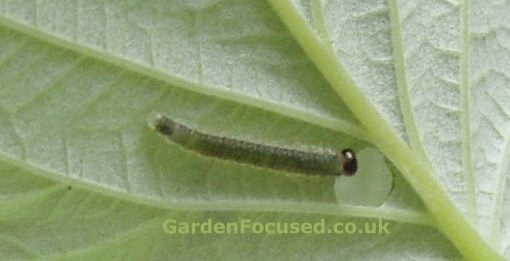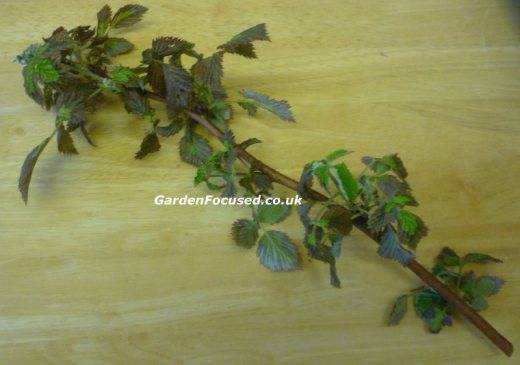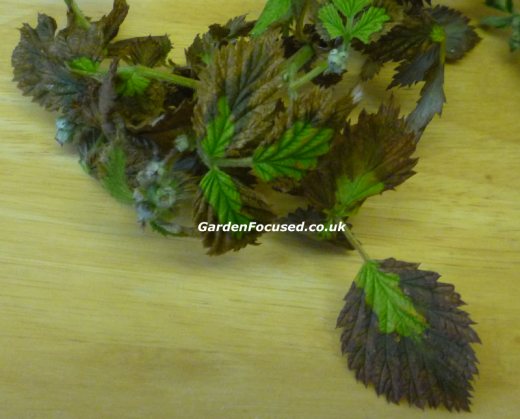RASPBERRY SAWFLY
Commonly called Raspberry Sawfly, the key sign of this pest are simple to identify, the leaves are reduced to skeleton and look like lace. The sawfly has five distinct stages to its life cycle and the damage is done in the fourth cycle, when the pest is a caterpillar. They eat the soft parts of the leaves leaving the veins completely alone. The fruit is also untouched.

Picture courtesy of reader Peter L.
Lower down we show a picture of the caterpillar which does all the damage. Some gardeners see the caterpillars but many report seeing none or only a few. Three factors account for the lack of a sighting:
- The caterpillars exist almost exclusively on the undersides of the leaves not on the upper surface. This is a natural defence mechanism, hiding themselves from the unwanted attention of birds which will eat them.
- They damage the leaves so quickly, stripping the lower leaves of an entire plant in a day or so, that they fall to the ground before you notice them. Only the damage is clear to see.
- They have two to three lifecycles within a year depending on weather conditions. The first lifecycle is usually the least damaging. The damage is there, as are the caterpillars, but in many cases not sufficiently serious to attract much attention. The second lifecycle is almost always the most serious and the speediest. If you watch this pest in action real time, only then will you understand that 5 caterpillars on a single plant can reduce many of the leaves to almost nothing in 48 hours. They just munch, munch and munch the leaves 24 hours a day.

The Raspberry Sawfly caterpillar
The life cycle of the Raspberry Sawfly is as follows:
- The larvae overwinter just below the soil surface surrounding the plants. If you can turn the soil over occasionally in late winter to early spring the birds may well feed on the larvae.
- When the soil warms up in spring the true sawflies emerge from the larvae and the first generation of the year is born.
- The sawflies lay eggs on the underside of the leaves typically along the edges of leaf veins. They are tiny, about 2mm, light green and translucent. If you spot any of these squash them with your fingers.
- Two weeks later caterpillars will emerge from the eggs and these are the ones which eat the leaves. If you see any, pick them off and throw them away.
- A couple of weeks later they fall to the ground, burrow slightly underground and the life cycle starts again. Two or three life cycles per year is normal depending on weather conditions.
There are insecticides available to kill sawflies, the most common being Westland Resolva Bug Killer containing Lambda-cyhalothrin although you need to get the timing spot on. Read the container for instructions.
RASPBERRY BEETLE
Raspberry beetles are tiny, brown and hairy and come to life in the soil in mid to late Spring. By themselves, they cause raspberry canes no damage at all but they do lay eggs on emerging raspberries in early summer. The eggs hatch as grubs which start feeding on the raspberry fruits, eating their way right through to the core if left untreated.
The life cycle is completed when, in mid summer, the raspberry beetle grubs fall onto the ground and overwinter there just under the soil surface ready to emerge next year as raspberry beetles.
Identifying raspberry beetles damage is easy, but unfortunately it occurs too late to prevent damage to the current year’s crop of raspberries. The first sign is of the raspberries being damaged and not forming correctly. Further examination of damaged fruit will reveal the grubs eating their way into the centre of the fruit.
We suggest not going down the chemical spraying route because the damage to other pollinating insects will be unavoidable. Also, the range of chemical sprays available to the amateur gardener is only partially successful in killing these beetles.
Our solution is threefold and attacks the lifecycle of the raspberry beetle at its most vulnerable stages. First, be sure to pick up all fallen fruit and dispose of it as soon as possible. This will prevent the beetles from laying any eggs on fruit at ground level.
Next, as soon as you identify the pests, remove all the top mulch and burn it. Cut all the canes to ground level and remove any trace of the canes and fruit – burn them. For the rest of the season up till about October, when the soil is dry, repeatedly hoe it. The objective is to expose any grubs in the soil to the elements and give them the least chance of surviving the summer and autumn as possible. At the same time this will also expose the grubs to birds who love to eat them.
The above two steps will have removed any grubs still feeding on the raspberry fruit and deprived them of their source of food. It will also disturb any grubs in the soil and expose them to the birds. The final step in eradicating the raspberry beetle is to prevent any beetles emerging from grubs surviving in the soil next year.
The solution is to line the whole raspberry patch area with four or five layers of newspaper, a cheap solution to a big problem. Then cover the newspapers with organic material such as wood chippings, compost or grass clippings. The newspaper and the covering will prevent any raspberry beetles emerging next year. Not only that, they will keep also keep the roots moist over the next couple of years.
CANE MIDGE, SPUR BLIGHT AND CANE BLIGHT
The Cane Midge and different forms of Raspberry Blight are grouped together because, although they are all very different, significant damage always starts with an attack of Cane Midge. The grubs of Cane Midge overwinter in the soil and initially emerge as tiny flies in late spring to early summer (dependant on weather conditions). The female fly lays eggs in splits which occur on the surface of raspberry canes and the grubs feed on the canes then drop to the ground to emerge as more flies later in the season. Up to four generations of Cane Midge can occur within a growing season.
The signs of Cane Midge are small brown marks on the raspberry canes, almost exclusively on young canes and only up to 30cm / 1ft high on the cane. The reason is that Cane Midge cannot fly well and tend to lay eggs just above soil level.
Cane Midge by themselves cause only minor damage to raspberry canes but they do cause damage which allows entry to canes of several forms of fungus. These fungi are generally referred to as Spur Blight and Cane Blight. It is these fungi which cause significant damage. The canes are infected and then grow irregularly producing a very poor raspberry crop. Signs of Spur Blight and Cane Blight are brown wounds on the canes which occur all over the canes, not just lower levels.
There is no cure for Cane Midge nor for Spur Blight and Cane Blight. Even commercial growers are fast running out of effective pesticides, and none of these are available to the amateur gardener. Infected canes should be dug up and burnt.
Although several erudite articles have been written concerning these pests none seems to have addressed the question of how Cane Midge initially attack a crop of raspberries. It seems likely that the Cane Midges are introduced by planting already infected canes. So, take a careful look at the health of new raspberry canes and burn any which show signs of infection.
Curing an attack of cane midge is not very well documented because in a commercial situation it is almost impossible to eradicate. However from an amateur gardener’s perspective there does remain the question of removing and burning an infected crop and then re-planting on the same ground.
The little solid evidence that exists shows that if the raspberry plants are removed in spring and then new crops are planted in autumn, the new plants will be considerably healthier. However, there is no evidence that the midges will be eradicated completely. This is based on trials held in Sweden where new raspberry shoots were removed entirely, leaving only one year old shoots.
This resulted in a vastly reduced incidence of cane midges but not a total eradication. Having read all the literature available it would seem that replanting in the same area where a previous attack has occurred should only be undertaken after 18 months. There is no evidence to suggest that the midges can exist in the soil after two years has elapsed.
YELLOW LEAVES WITH GREEN VEINS
There are a couple of possible reasons for this problem, the most common being a magnesium or iron mineral deficiency. Less likely but still not rare is a virus infection. Mineral deficiencies can be treated so try to cure that problem first. Virus infections cannot be treated and require the raspberry canes to be dug up and burnt.
MINERAL DEFICIENCIES
If younger leaves are the most affected then first treat for iron deficiency. Buy a pack of Sequestrene form your local garden centre and apply it to the ground around the raspberries at the rate stated on the instructions.
If this cures the problem, apply the Sequestrene next year because it is not a permanent solution. The only permanent solution is to increase the acidity of the soil so that iron can more easily be taken up by the raspberry bushes.
If older leaves are most affected, suspect a magnesium deficiency. The long-term solution to a magnesium deficiency is to add Dolomite limestone (readily available at garden centres) to the soil at the dose recommended on the package. Do not exceed the dose because doing so can result in too much calcium which in turn inhibits the roots ability to absorb the magnesium. Dolomite limestone is a slow release product which lasts for a long time in the ground.
A more immediate remedy for magnesium deficiency is to spray the foliage with a solution of water and Epsom Salts. The ratio is 20g of Epsom Salts added to a litre of water and a few drop of washing liquid will help the spray to stay on the leaves. Spray again after a fortnight.
VIRUS INFECTIONS
It is extremely difficult to initially know if a raspberry bush is suffering from a mineral deficiency or a virus, the symptoms of yellow leaves and green veins are the same. It’s best to treat for a mineral deficiency first because the only action you can take with a virus infection is to dig the plants up and burn them. Don’t plant raspberries (or strawberries) on that patch of land for five years or so.
Virus infections initially show yellow leaves / green veins, but they will also begin to show signs of stunted growth and poor cropping over a couple years. If left untreated the bushes will eventually die out.
OTHER CAUSES
If you suspect a virus infection then as stated above, the only action is to dig the bushes up and destroy them. Raspberry bushes will naturally become infected with viral and fungal problems over time. It’s probably best to assume a life span of eight to ten years, after which they are likely to need replacing.
If your raspberry bushes are significantly younger, yellowing leaves could possibly be caused by cane midge (see here) but there will be additional signs as well. Raspberry Root Rot could also be the problem, but there will be other symptoms. The fruit will either fail to form or be very small, stems will be short and generally look unhealthy.
Root rot is best diagnosed by digging up a plant and examining the roots. They will look unhealthy and, as the name suggests, rotting. They will also have red marks on them where the fungus has initially entered the plant.
BIRDS AND RASPBERRIES
If you read up about pests and raspberries on the internet then you could well come to the conclusion that birds are a major pest for raspberry growers. But if you look a bit more closely at the authors of the articles who make these claims then it becomes apparent that many of them are in fact selling fruit cages and bird protection netting. Some authors of the articles seem to have simply scraped the information from other articles.
In our experience however, birds do not eat raspberries, they have never affected our crop and we have never met anyone who has had a problem with them. Indeed, original and informed articles on the internet do not mention birds as a problem for raspberries.
See one of our readers comments (dated 11th July 2016) at the end of this article for a different perspective on birds eating raspberries.
However, if you have a problem with birds then the only real solution is a fruit cage or some other form of protective netting. Click here for our article on the benefits and pitfalls surrounding fruit cages.
RASPBERRY ROOT ROT
The symptoms of the fungal disease Raspberry Root Rot are:
- The plants don’t grow strongly as normal
- Leaves begin to wilt
- Leaves turn brown at the edges (see picture below)
- Leaves eventually die but tend to remain on the canes
- Digging up the roots shows them them to be brown / black and dying.
- Often only individual plants are affected
- Symptoms normally appear in mid spring to early summer

![]()
A raspberry cane with Raspberry Root Rot
(click to enlarge)

![]()
Leaves affected by Raspberry Root Rot
(click picture to enlarge)
The causes of Raspberry Root Rot are:
- Heavy ground such as clay
- Ground which is water logged, especially in early to mid spring
- These ground conditions encourage the fungus to grow and spread from one plant to another
- This is a soil borne fungus-like infection
- The infection can remain in the soil for several years after removing infected plants
The technical name for Raspberry Root rot is Phytophthora albi and it occurs around the world. Because the infection is caused by bad soil conditions there is no practical cure for the amateur gardener, prevention is the key. If your plants are affected by this infection, dig them up, burn them and plant any new raspberry canes in a better position.
Avoid planting in heavy or water logged soils. Where this is not possible plant them in raised beds about 30cm high filled with soil that drains well.
COMMENTS / QUESTIONS LEFT BY OUR READERS
| Date: 11 July 2016 | From: Jo |
| I would like to thank you for your article on raspberries and found it both informative and helpful. However, the local blackbirds and thrushes love the raspberry fruit that is just above ground level. I was picking raspberries on one side of my bushes, and birdie was on the other side, beneath the bush thinking that I hadn’t noticed her/him. I watched as it tugged at a raspberry. Half came off, then after another tug, so did the other half. They are getting much too clever. This has happened just the past couple of years, but there is lots of fruit for me, and them as they can’t get to the ones higher up. The smaller birds have had a go, but never manage it.Hope you don’t mind me slightly challenging your bit about the birds and raspberries! | |
| Date: 24 April 2016 | From: Jill |
| My raspberries have cane blight and need to be removed now. If I replant in Autumn will the midges still be in the soil and attack the new canes, or should I completely replace the soil before replanting?
ANSWER: I have updated the Cane Midge / Blight section to include the latest information available to answer this question. |
|
| Date: 28 September 2015 | From: Geoff L |
| My raspberry plant has been attacked by sawfly. If I now leave it until next year will the plant regenerate itself with fresh leaves?
ANSWER: Almost certainly it will grow back next year. However, the larvae will overwinter in the soil and begin their attack next year. So keep an eye out for caterpillars on the underside of the leaves next year. It may also pay off to gently loosen and turn over the top soil around the plant – not too deep though because the roots are shallow. The birds may well eat some of the disturbed larvae. |
|
| Date: 11 May 2015 | From: Mike |
| What is causing lots of small holes in my raspberry leaves? Can’t see any caterpillars or insects, help!
ANSWER: Several readers have reported this problem and we have added a section above entitled “Raspberry Sawfly“. Two pictures sent in by Peter L have been used to illustrate the damage and the caterpillar. |
|
We have temporarily disabled more questions because we are unable to cope with the workload of answering them at the moment. We are seeking more staff to help with this problem.
RASPBERRY PESTS AND DISEASES
By David Marks
Raspberries are strong growing fruits and certainly for the first five years of their life suffer from few pests and diseases. However, as with all plants, sometimes things go wrong and we will help you identify and treat raspberry pests and diseases. The most common pest is the raspberry beetle and this is treatable. Next is the cane midge which damages the canes but not enough to cause a problem by themselves. However they open up the canes to other diseases which can cause raspberries major health problems.